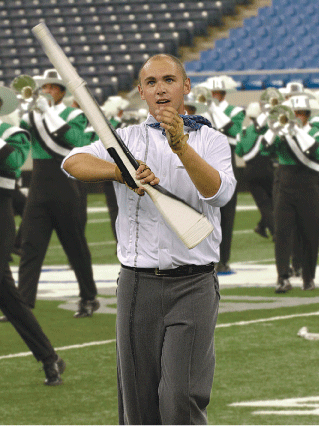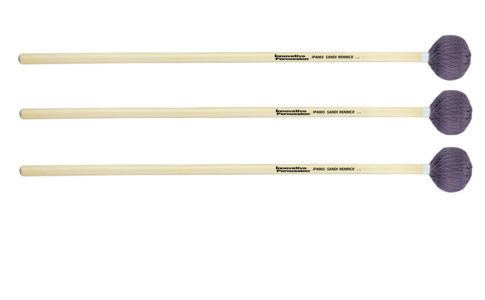|
Sponsored by |
Presented by Halftime Magazine and Marching.com
Just as the art of color guard is continually developing, so is the evolution of the rifle and its opportunities for performance and expression. While there are many factors in your purchase decision, the type of material is a predominant factor. Here are the pros and cons of plastic vs. wooden rifles when it comes to performance, durability, care and cosmetic style.
Photo of The Cavaliers Drum and Bugle Corps courtesy of Director’s Showcase International
The rifle is, without a doubt, the most powerful piece of equipment in the color guard arsenal. It portrays the characteristics of power, agility and artistry with its very presence in any color guard show. Performers on rifle are often considered the elite of a guard due to the high degree of control and precision that is required to spin successfully.
When choosing a rifle, often the first decision is whether to buy plastic (polyethylene) or wood. Plastic rifles are a newer innovation compared to wood, which has existed since the very inception of color guard. So what are the differences in performance and care of these rifles?
Show Performance
With both wood and plastic, you will need to be careful about the slippery aspects of the rifle’s surface. When spinning a plastic rifle, hand placement can be a bit tricky due to the slick surface of polyethylene. Gripping the rifle is a bit more challenging with plastic.
In contrast, when it comes to wood, once they are taped, they present little slippage in the manipulation of the rifle.
Both can be ordered with straps that offer versatility in choreography and technique.
Weights
Manufacturers of plastic rifles say that they are perfectly balanced in the construction process. There is no need to apply additional weights. If you order a group of rifles, they should be a consistent weight coming out of the box.
However, with wooden rifles, instructors will need to weight them for the specific needs of their guard. Due to the natural variation in wood, some may be lighter or heavier than others. Performers find that even a variance of a few ounces will make them feel very different, so instructors may need to make extra effort to ensure that each guard member receives “their” rifle each time.
Durability and Care
Is there a variance in life expectancy or durability? Absolutely!
Plastic rifles generally come with a manufacturer guarantee against breakage under “normal usage.” The material of polyethylene itself is highly crack resistant, so you are not going to see a great deal of damage done through continual dropping. Yet there are some possible side effects.
After continual dropping, the polyethylene material can have a tendency to warp a bit. When this situation occurs, it creates a kind of bounce back from a drop that can be a bit unpredictable. In addition, if the warping gets too bad over time, you may (and I stress the word “may”) see the effects of the warping in the air or while spinning.
In addition, plastic rifles tend to fray a bit at the ends. This really isn’t a durability issue, but more of a cosmetic concern. You can always tape over the fraying.
Finally, due to the porosity of the polymer, plastic rifles can pick up smells. The rifle may begin to smell like grass, mud or whatever environment that it is exposed to.
On the other hand, wooden rifles are made from dense poplar or aspen wood. They need to be taped in order to protect them from damage. Once taped, they are difficult to break. However, they can and do break if they are dropped continuously on hard surfaces. For this reason, some instructors tend to choose plastic as a training rifle for those performers that experience many drops. But performers get good quickly and will want a wood rifle eventually.
Water damage over time can also have an effect on the wood, but if you care for the rifle correctly, this concern can all but be eliminated. To prevent damage from moisture, do not store the rifle outdoors or even in a shed where it may be exposed to the elements. These facilities aren’t always weather tight, especially during East Coast winters.
Cost
Rifles can cost anywhere from $25 to $50. Generally this price range does not reflect the material of the rifle itself, but more of the make, fabrication, size/length and accessories purchased.
Cosmetic Variances
Rifles can be ordered in different sizes and lengths. The measurement of a rifle does not reflect the discrepancy between wood and plastic. Each composition offers the same availability in length.
Plastic rifles can be purchased in various colors whereas wood is somewhat limited in color choice. However, color guard shows are always changing, and a color ordered one season might not be the desired color in the next season.
Electrical tape (available in virtually every color in the rainbow) steps in and fills the necessity for change. Both plastic and wood rifles can be taped to provide added color or emphasis in the design of any show.
The Bottom Line
Instructors and show designers alike sing the praises of wood rifles. It has a comfort level that cannot be obtained with a plastic rifle. There is a consistency in training that occurs with a wood rifle because the product will not alter over time and usage.
Because of this reliability, wood lends itself well to modern-day and progressive choreography where designers are experimenting with weight shifts and rifle usage and performers are constantly moving in diverse spatial planes. The complexity of the shows may lead to more drops overall.
It would seem that at this point in the color guard activity, wood truly is the Rolls Royce of rifle choice. While it has been around for a very long time, you just can’t beat the quality and dependability of a wood rifle.
About the Author
Chris Casteel has been involved in the marching band activity since 1981 as a color guard performer and instructor. As a performer, she marched in the 1984 Summer Olympics. As an instructor, she has worked with several medaling guards in the Winter Guard Association of Southern California (WGASC). She has also been an adjudicator for the Southern California Band and Orchestra Association (SCSBOA) and the WGASC for nearly 7 years. In addition, she has held the position of Education Coordinator for the WGASC since 2008 where she authors several educational articles. Casteel’s articles also appear on the colorguardeducators.com website. Currently, Casteel is a full-time middle school teacher who specializes in Language Arts /Writing.
About the Sponsor: DSI
DSI (Director’s Showcase International) is the premiere wholesaler of marching band accessories and accessories for guard including wooden & plastic rifles, footwear, flags, poles, guard outfits, and other accessories. DSI brands include Elite Rifles & Sabres, Starlite Dance Boots, MTX & Viper Marching Shoes, Command Center Podiums, and Ever-Dri Performance Gloves. To see the complete line of DSI products please visit http://dshowcase.com.


